Affiliate links on Android Authority may earn us a commission. Learn more.
Samsung Galaxy S21 Ultra review second opinion: A wolf in wolf's clothing
February 6, 2021
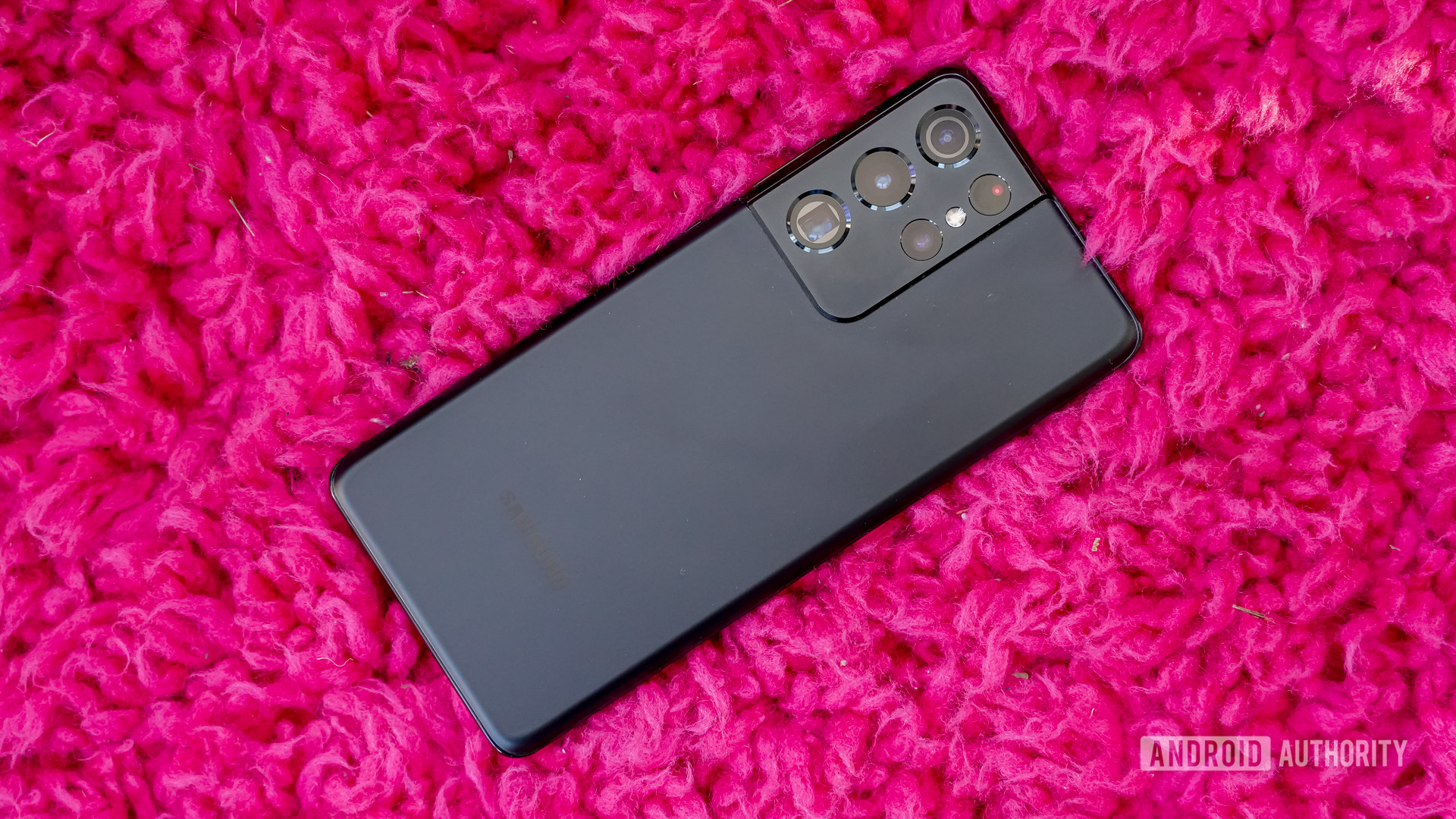
Apex predators stand out for a variety of reasons. They are often signified by their sharp fangs or claws, aggressive behavior, and stealthy approach to their prey. Samsung, long one of the top dogs in the smartphone market, is taking a similar tack with its latest flagship, the Galaxy S21 Ultra. The phone has a sharp design, aggressive camera module, and hidden strength thanks to specs that kill. The Samsung Galaxy S21 Ultra doesn’t pretend to be anything other than what it is: an apex predator in the smartphone kingdom where it slays much of the competition.
After using the smartphone for nearly a week and thinking about Samsung’s previous phones, it’s easy to see that the company has been on a journey. The 2020 Samsung Galaxy S20 Ultra was a solid first attempt. It set the blueprint for what was to follow, even if it didn’t necessarily succeed itself. Later, the Galaxy Note 20 Ultra made improvements upon the S20 Ultra’s blueprint, even if they didn’t go quite far enough. With the S21 Ultra, we finally see Samsung hitting its stride and delivering the phone many have hoped for.
That’s not to say it’s perfect. Even the world’s top predators have faults and weaknesses. While I agree with much of our initial review (see below), I do have some of my own thoughts. Here is Android Authority’s Samsung Galaxy S21 Ultra review second opinion.
Our verdict: Samsung Galaxy S21 Ultra review
Blunt, but purposeful build
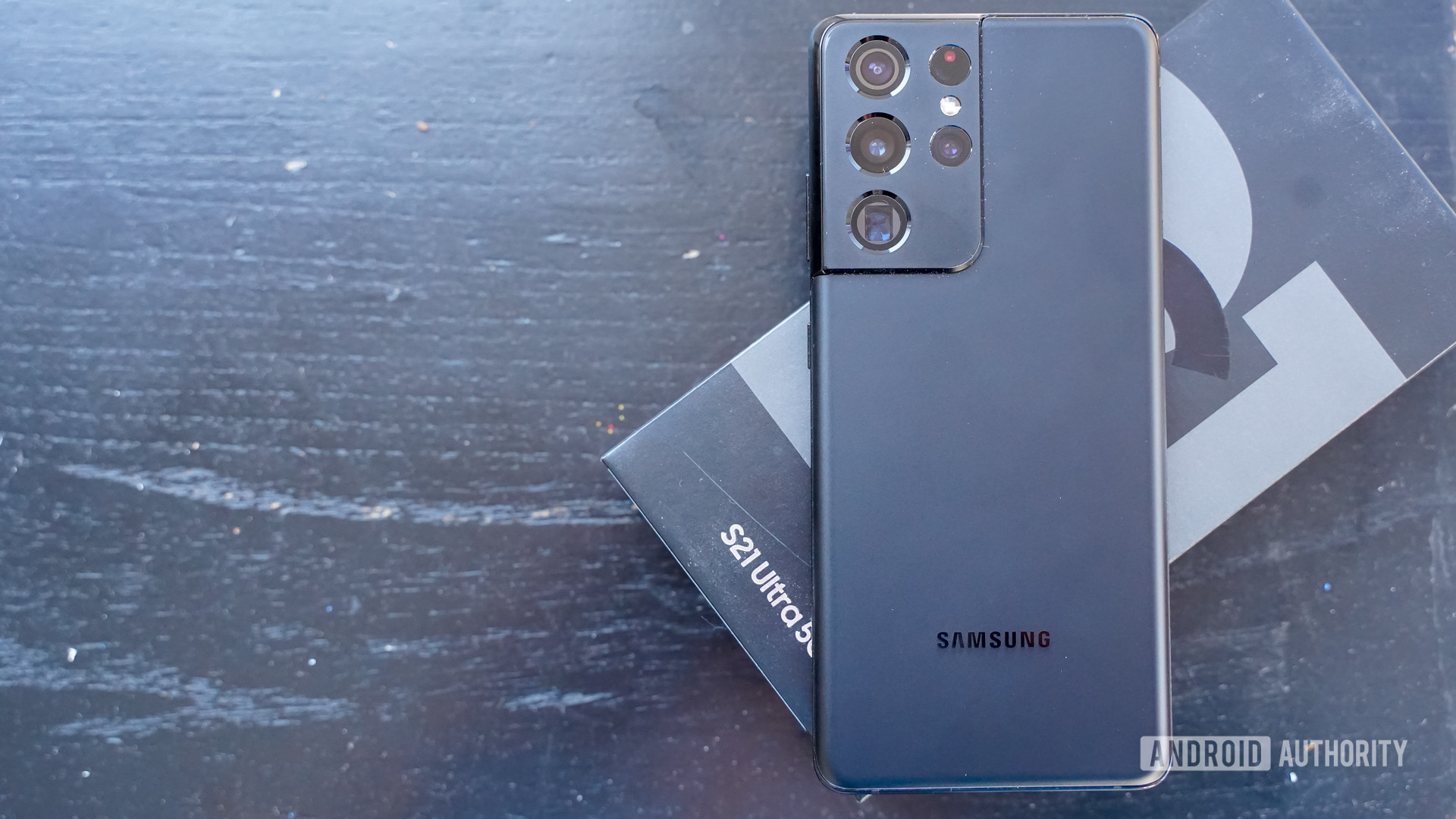
Smartphone design has homogenized over the years, particularly in the premium space. You often get a sizable metal-and-glass slab with a significant camera module on the back and a distinct display on front. The same is true of the Samsung Galaxy S21 Ultra.
The phone is massive, but not so massive as the S20 Ultra — and that’s all that matters. The S20 Ultra was a bit too big. Samsung dialed the screen size in a tenth of an inch and that allowed it to shrink the footprint of the new phone by 2mm in height and fractionally in width. These small measurements are a big deal. The sizing reduction, while minor, makes a world of difference in usability. Samsung couldn’t escape adding some weight, however, and the S21 Ultra is notably heavier than the S20 Ultra at more than half a pound (229g).
Some are sure to complain about Samsung's pivot away from microSD card support, but otherwise the Galaxy S21 Ultra builds and improves on the Galaxy S20 Ultra's design in all the right ways.
The materials are top-notch. The phone has a beefy metal frame that encircles the device and two glass panels that sandwich the aluminum. Samsung went with matte finishes this year and I appreciate that. The glossy look to last year’s S20 Ultra was a bit much. The clean look of matte surfaces is appealing and the black of our unit is particularly stealthy.
There’s no escaping the camera module. Last year, the module was a tacked-on platform that looked just awful. It’s no less huge, but at least the S21 Ultra’s camera module doesn’t look like an afterthought. Samsung extended the mid-frame up and around the camera module, protecting it with metal. I like that Samsung integrated the design just a bit more than it did on older phones.
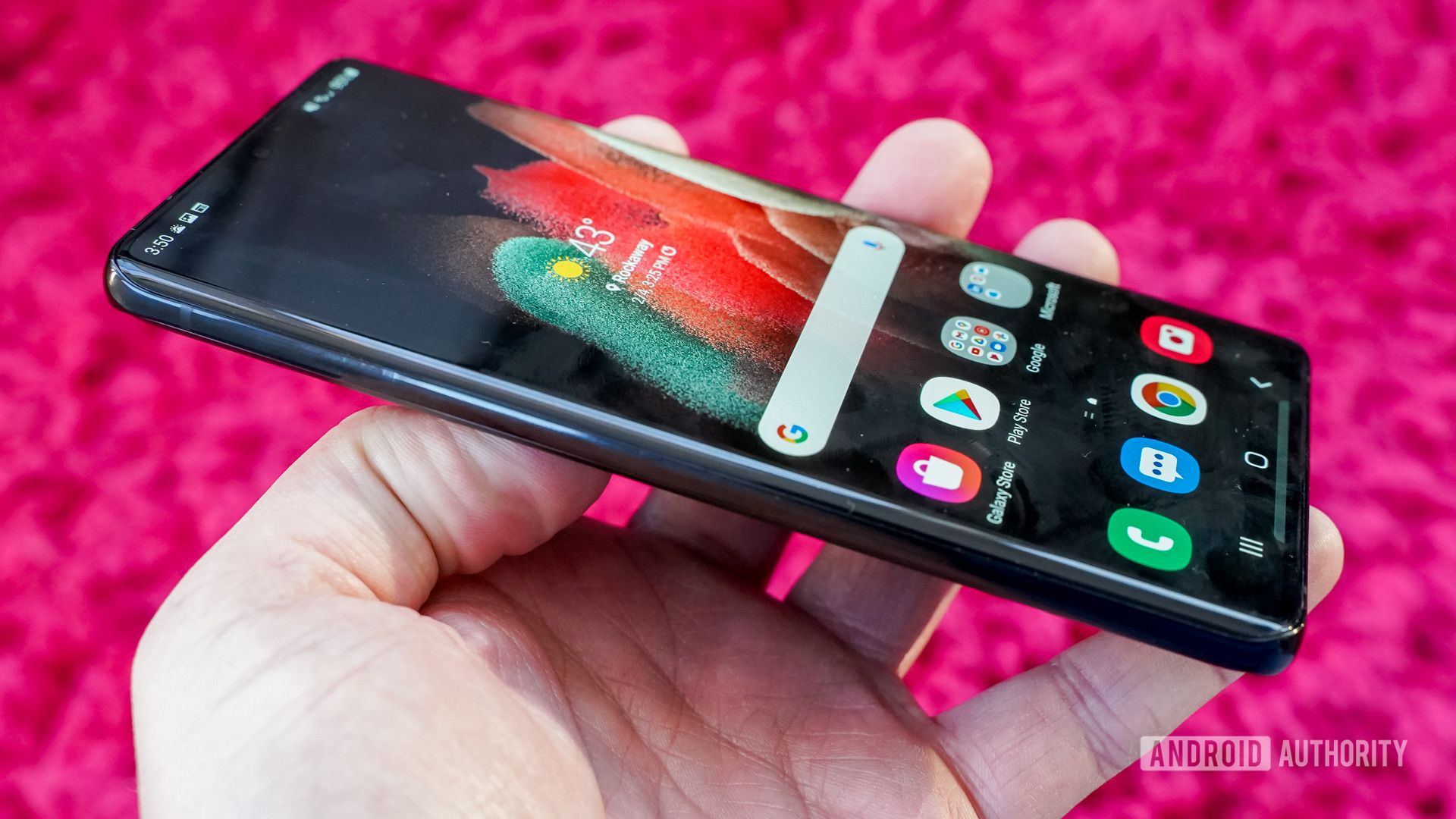
As for the rest of the design, it’s functional in the way that a flagship should be. Mostly. Some are sure to complain about Samsung’s pivot away from microSD card support. I certainly hear ya. Samsung has long offered microSD slots on its phones as a point of differentiation. This year, there’s no slot. But I think we need to accept it and move on. The majority of flagships these days don’t include memory card support and Samsung offers 256GB for just $50 more than the base price. That’s more than enough storage for most people.
You get everything else: waterproof design, fast USB-C, stereo speakers, and more. I only wish there were more colorways available than just black, navy, and brown.
Samsung Galaxy S21 Ultra alternatives: 6 phones to consider before you buy
Cinema experience only half there
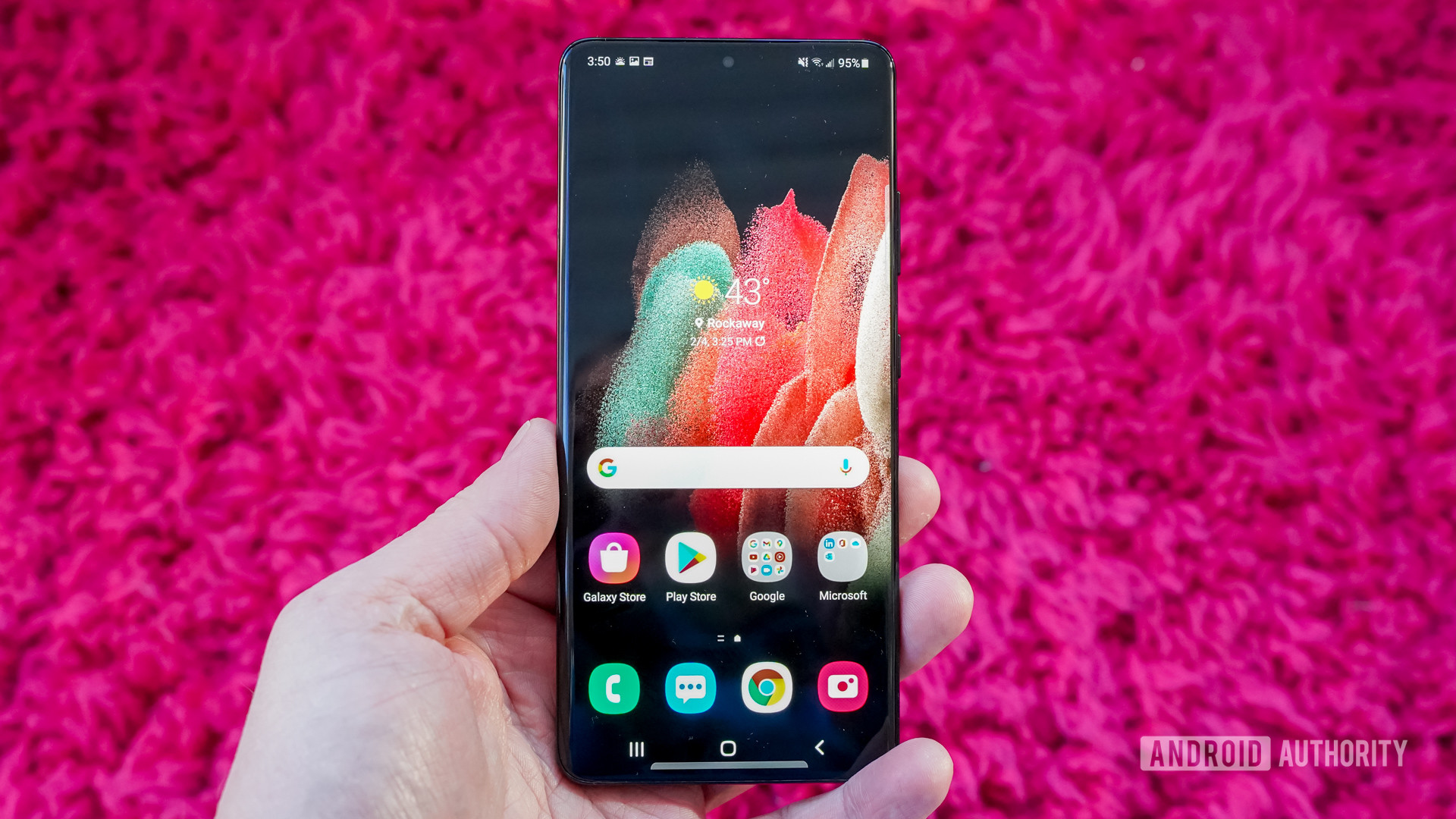
Samsung is one of the world’s top display makers, and that’s evident (once again) on the company’s flagship product. The 6.8-inch screen is a joy to use and look at. It’s the only screen of the S21 family to offer pixel-rich 3,200 x 1,440 resolution. The other S21 phones have Full HD+ screens. Samsung’s Super AMOLED tech is beyond reproach at this point and delivers outstanding color, brightness, and contrast. Let’s not forget about the super-fast 120Hz refresh rate. You’ve also got Corning Gorilla Glass Victus for protection.
I agree with our original review in that the limitations of the 120Hz display are frustrating. You can set the screen to a consistent 60Hz no matter the resolution, but the 120Hz is only available in adaptive mode. This means it changes depending on the activity. For example, it will scale down to 10Hz if you’re just looking at the home screen and then ramp up to 120Hz when you’re gaming. I wish you could force it to 120Hz all the time, but I get that Samsung limits this for its potential hit to battery life.
The S21 Ultra really knows how to handle video content.
I watched several episodes of The Mandalorian, The Expanse, and WandaVision on the phone and came away impressed with the visuals. The S21 Ultra really knows how to handle video content. I was really impressed with the way it handled The Expanse, which is a dark show full of shadows and contrast.
While Samsung knocked the screen out of the park, I think it bungled the other half of the cinema experience: sound. The stereo speakers are certainly loud enough. No complaints there. I disagree with David’s assessment that sound is crystal clear. In fact, I thought the speakers sounded quite muffled. This really impacted my appreciation of the device as an entertainment platform, as it forced me to don Bluetooth headphones for better sound. Often I like to watch video casually without headphones. It works fine, but the iPhone 12 Pro Max sounds a lot better.
Guts git ‘er done
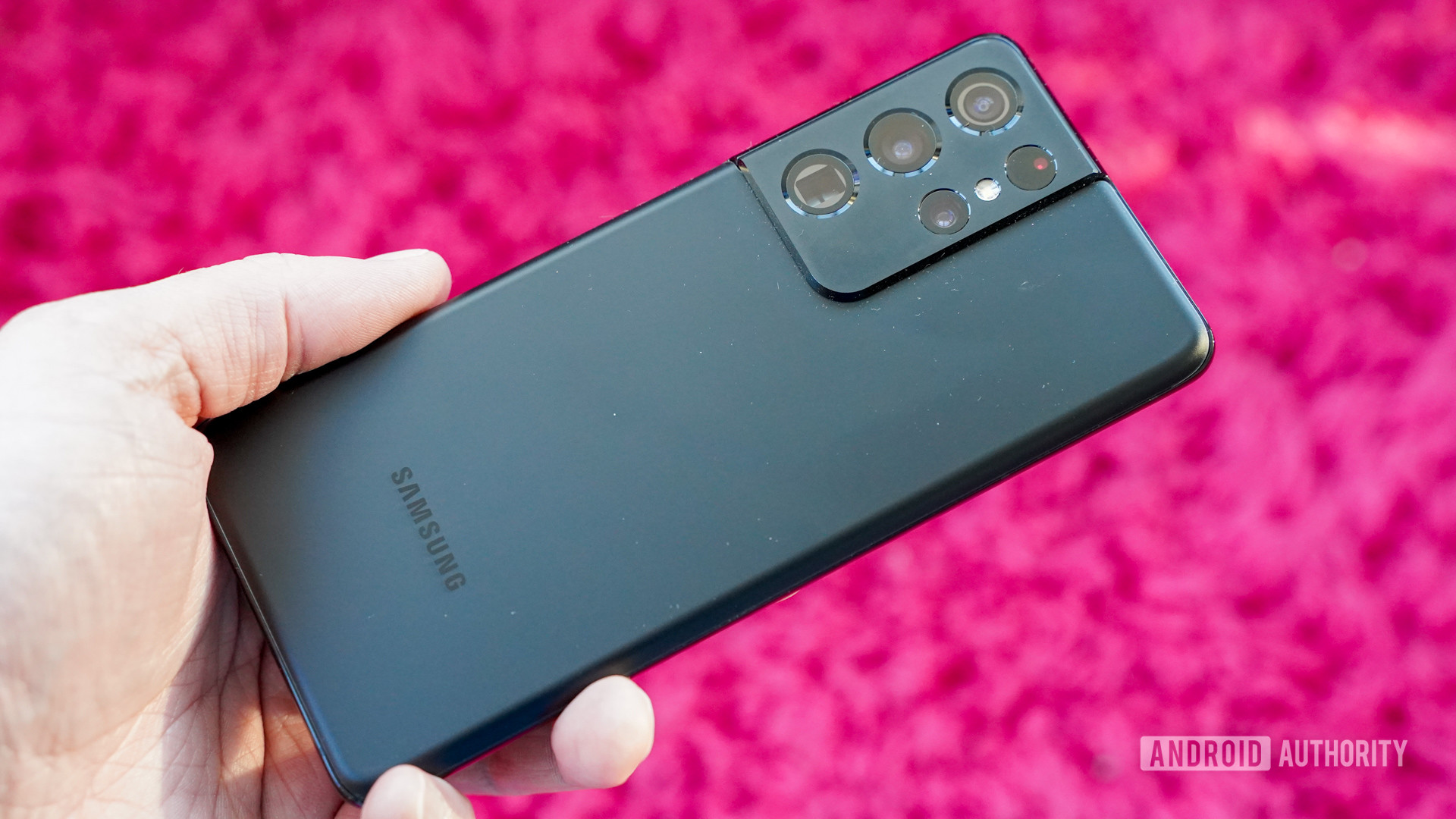
The Samsung Galaxy S21 Ultra has plenty of power and stamina. Our review highlights the prowess of the Qualcomm Snapdragon 888 processor, which lands a crushing blow against every other Android phone in the market (for the moment). Qualcomm’s premiere chip will surely make its way to myriad flagships over the next year, so expect to see competition heat up between phones as time goes on.
Practically speaking, the S21 Ultra has more than enough processing punch to tackle any task you may throw at it. Games such as Asphalt 9 and Fortnite didn’t tax the phone at all. I was able to multitask with ease, and running multiple windows didn’t seem to bother the phone at all thanks to the generous helping of RAM.
Galaxy S21 Ultra Snapdragon vs Exynos: How big is the performance gap?
The 5,000mAh battery, too, handles plenty of punishment. For a phone with a screen this big and a processor this powerful, Samsung was able to fine-tune its energy algorithms enough for a full day’s use and then some. The phone never struggled with battery life, at least as far as single-day use was concerned. I ended most days with at least 40% in the tank, if not more. That included plenty of gaming, YouTube, social networking, and camera use. Bottom line: I often saw one and a half to two days of battery life with the phone. That’s solid.
If you're upgrading from a phone that's several years old, you might have to run out and buy a brick. Bleh, Samsung.
As always, you can tweak the phone to get more from the battery. These include dialing the resolution up or down, changing the refresh rate, keeping brightness in check, managing background tasks, and much more.
The one complaint I have is the charging situation. Sure, Apple ditched the charger first, but that doesn’t mean Samsung had to follow suit. With no charger in the box, you’ll have to rely on an old(er) brick you have laying about. Perhaps worse, the supplied cable is USB-C to USB-C. If you’re upgrading from a phone that’s several years old, the brick you have is likely USB-A. That means you might have to run out and buy a brick. Bleh, Samsung.
See also: How fast can I charge my Samsung Galaxy S21 with an old charger?
Then there’s 5G. All of Samsung’s modern flagships have had 5G, as have some of its mid-range phones. 5G is considered essential for a top-tier phone. I tested the phone briefly on Verizon’s mid-band 5G and didn’t come away impressed. This isn’t the S21 Ultra 5G’s fault. Verizon’s mid-band spectrum, which is what’s available where I live, isn’t the same as its mmWave 5G. Most people who buy the S21 Ultra 5G will only see mid-band service, which is only about as good as 4G LTE service right now. In other words, don’t get too excited about 5G for now. Verizon’s mmWave will be more widely available over time, though mostly in city centers.
Photographic flex
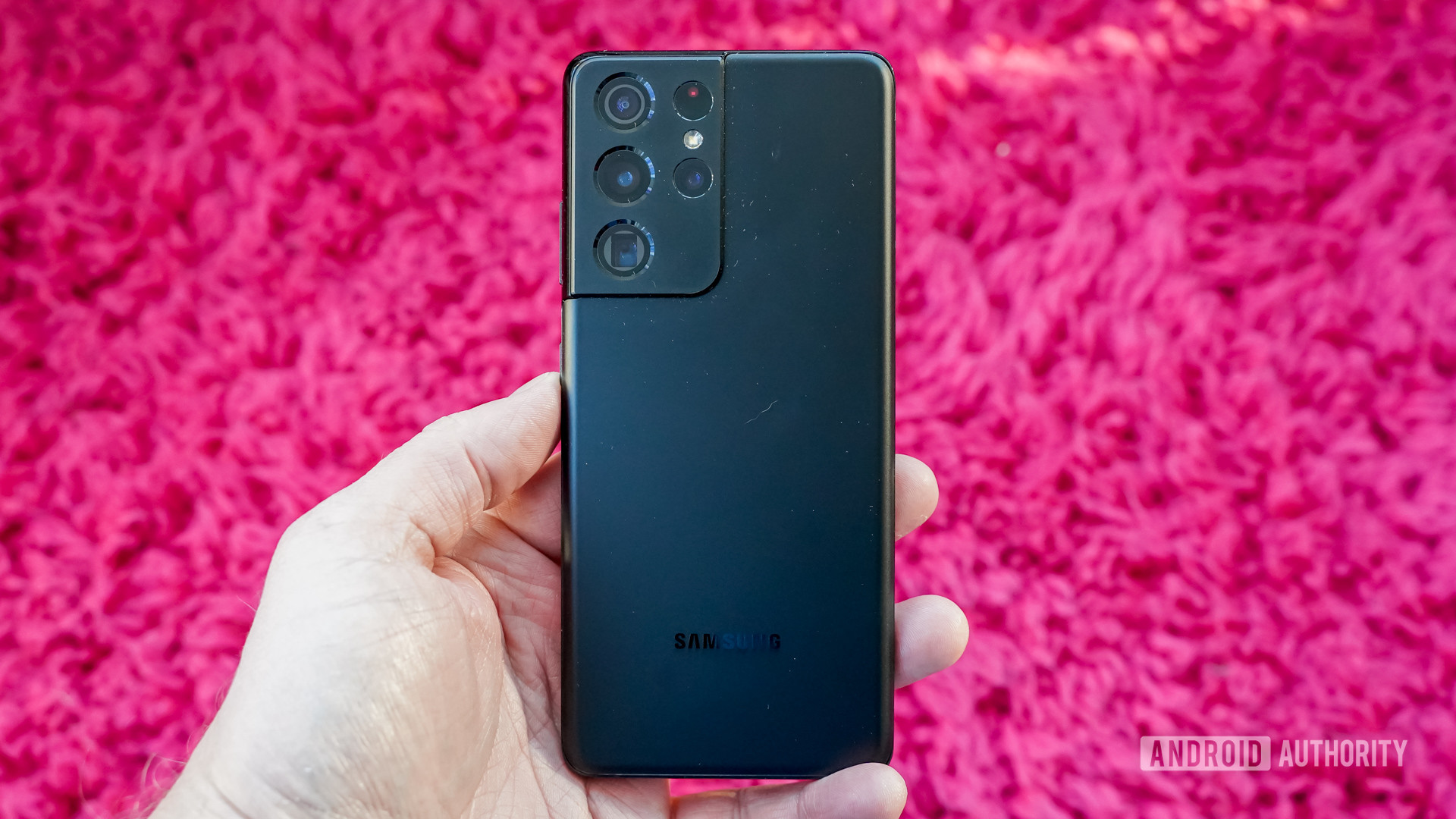
Samsung wants its cameras to be among the world’s best, and it takes a step in the right direction with the Galaxy S21 Ultra. Last year’s S20 Ultra was a bit of a mess, with serious focusing issues plaguing the main 108MP shooter. Those problems are now resolved and the two (count ’em, two!) telephoto lenses mean the device is more flexible than most when it comes to zoom.
David dove really, really deep into the camera in his full review of the S21 Ultra, and I wholeheartedly recommend you read through his musings. What I’m going to say is this: once you get over the usability curve, the S21 Ultra rivals the best in the business. Apple and Google set up some serious competition in the iPhone 12 Pro Max and Pixel 5. These phones are industry leaders with good reason. Samsung’s phone goes toe-to-toe with both in terms of photo quality. It’s only a step behind from time to time, and some might give it the go-ahead vote based on its 3x and 10x telephoto lenses.
The app is powerful and feature-rich. Everything you need is a thumb press away. Controls provide you access to the zoom lenses, the shooting modes, the shutter, and gallery, as well as minor tools such as filters, aspect ratio, timer, flash, and the full settings. Shooting modes are plentiful and include AR doodle, pro, pano, food, night, portrait, portrait video, pro video, super slow-mo, slow-mo, hyper-lapse, and director’s view. All but the last should be familiar to you. Director’s view lets you preview the other lenses when shooting through one of the others. This is clutch for video, as it might help create a better shot by zooming in or out on your subject. It’s neat too, if somewhat advanced. The scene optimizer is on by default and will help to automatically choose a shooting mode. It works very well, particularly when it comes to recognizing night and text scenes.
The Galaxy S21 Ultra camera results speak for themselves.
You can dial in zoom from 0.6x all the way to 100x using a combination of optics and software. The physical lenses capture 0.6x, 1x, 3x, and 10x. That alone is more than most phones, and the clarity of those 10x shots is impressive. I really like the flexibility here. Zoom, more so than the fancy software shooting modes, is what should attract users to this camera.
The results speak for themselves. Photos taken in all types of settings are “good” at a minimum and excellent at the top end of the range. I saw sharp focus, accurate color (at least, more accurate than we’re used to from Samsung), and proper white balance/exposure.
Video powers ramp up to 8K shooting. While I wasn’t truly able to sample 8K video, the 4K at 60fps footage I shot looked excellent.
User interspace place
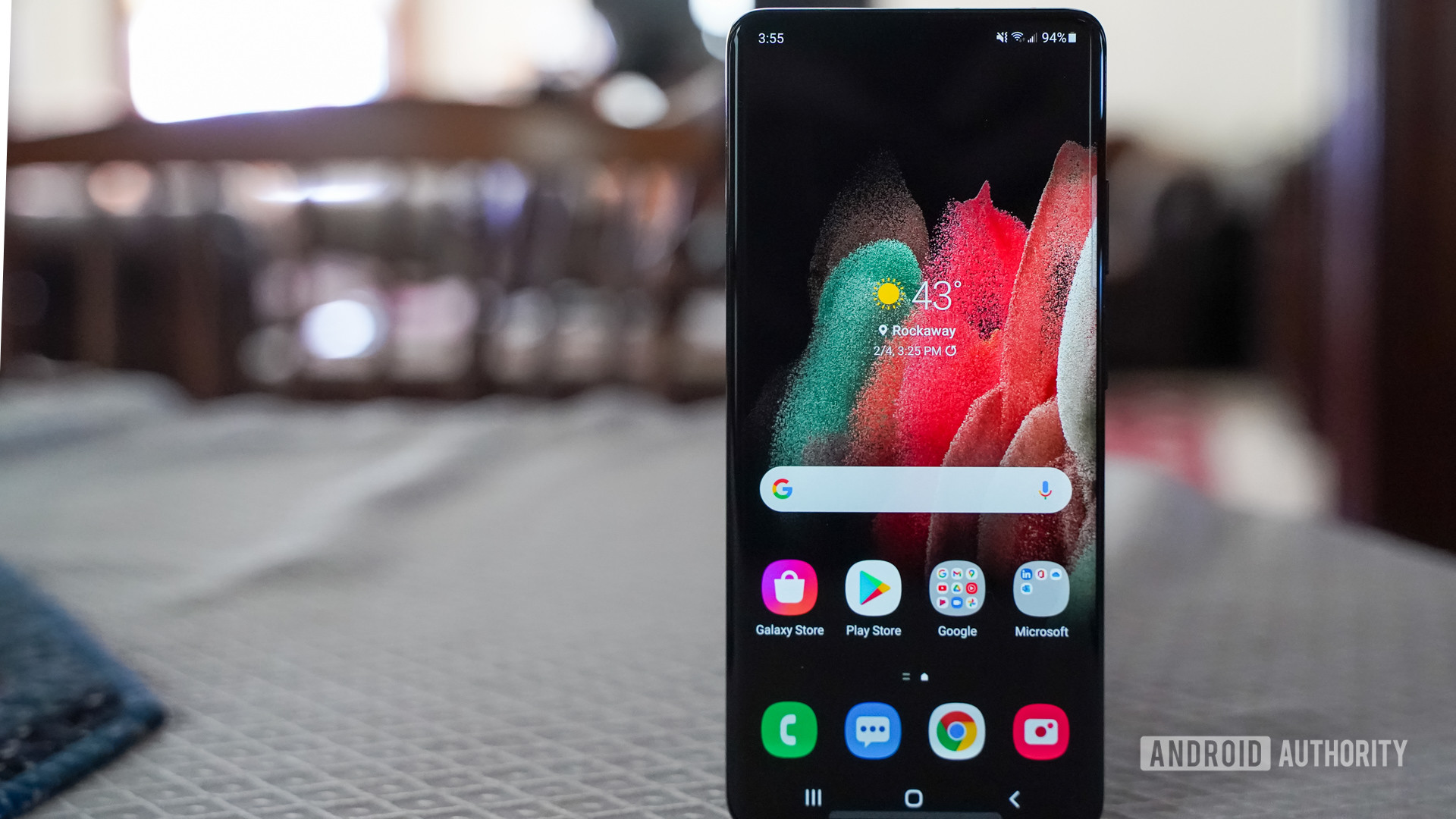
The Galaxy S21 Ultra ships with Android 11 and One UI 3.1, which is the latest from Samsung. The company continues to refine its user interface software and UI 3.1 is about the best we’ve seen from Samsung.
Users familiar with Samsung’s design language will feel right at home. Facets such as ions, fonts, and other design elements are largely carried over from older versions of One UI.
There’s some good and bad with the new system. First the good. Samsung has committed to three years of system updates for the phone. That’s fantastic news, particularly for those who like to hold onto their phones for more than a year. Now the bad. Samsung had decided that it’s a good idea to cram small ads in the alert shade. This is a major no-no and I don’t like it one bit. Samsung needs to cut this out.
Samsung has committed to three years of system updates for the phone. That's fantastic news.
Perhaps my favorite change is that Samsung now allows you to select the Google Discover feed or the Samsung Free feed. Samsung has long locked users into its own feed, so adding the option to Google Discover — which is what I prefer — is a major bonus.
I’ll point out here that the S21 Ultra and One UI 3.1 support Samsung’s S Pen stylus. Our team has tested it out, and yes, it works. You’ll have to buy the S Pen or third-party stylus separately and figure out on your own where to garage it. Samsung makes a case for the phone that also holds the S Pen. I haven’t used it, but it looks hella awkward.
Samsung Galaxy S21 Ultra review second opinion: Hypebeast
Suffice it to say, I came away from using the Samsung Galaxy S21 Ultra impressed. It’s a fine piece of hardware and features a more cohesive design than some of its progenitors. It may be big and heavy, and may lack a microSD slot and headphone jack (and charging brick), but everything else is in there. That means a waterproof design, top processor, ample battery, advanced camera system, 5G, Android 11, and three years of software updates.
Should you upgrade? Samsung Galaxy S21 vs older Galaxy S phones
Among the premium phones in the market today, the Samsung Galaxy S21 Ultra 5G is the top dog. For now.
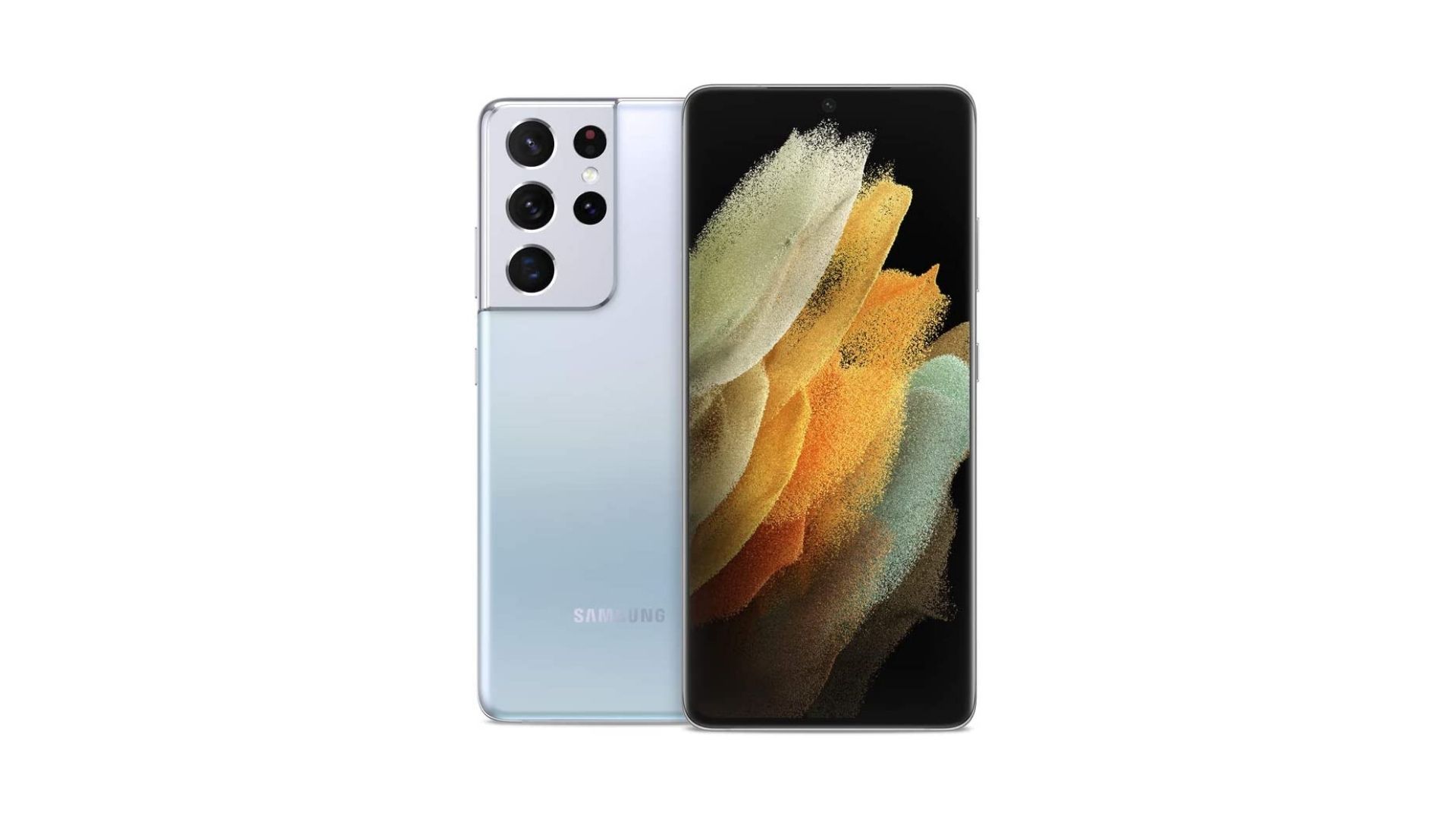
For more reviews from Android Authority, sign up below to receive all of the latest device testing and analysis straight into your inbox.